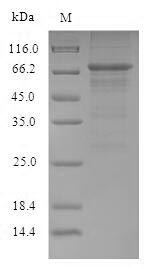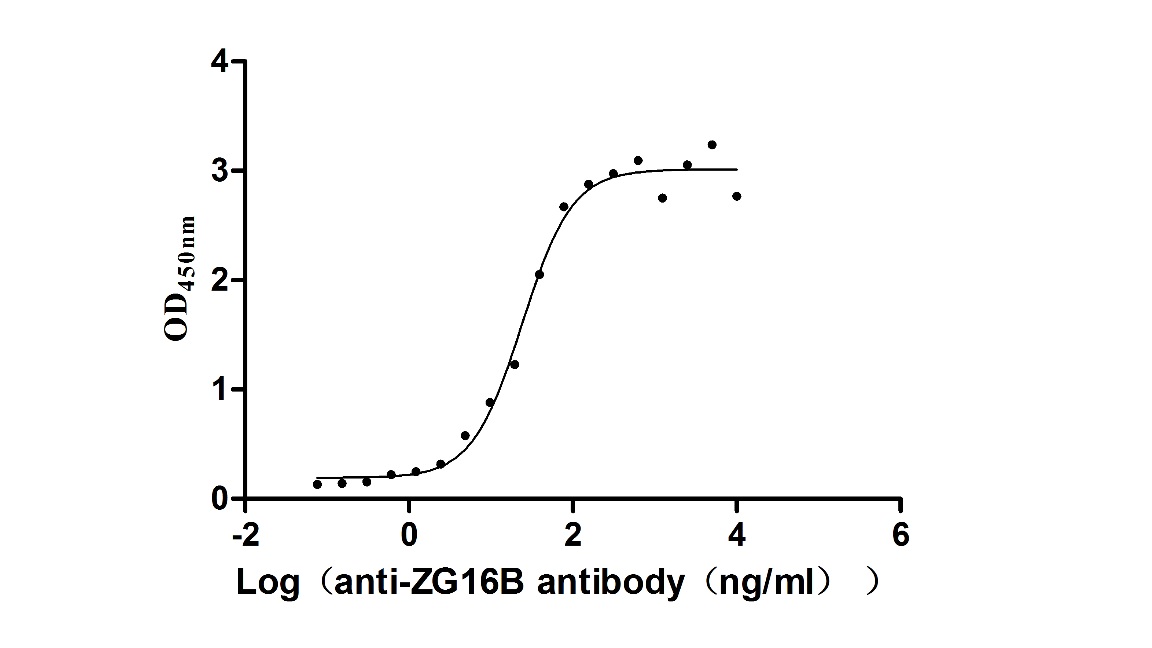Recombinant Influenza A virus Nucleoprotein (NP)
In Stock-
货号:CSB-EP356056IFZ
-
规格:¥2328
-
图片:
-
其他:
产品详情
-
纯度:Greater than 90% as determined by SDS-PAGE.
-
基因名:NP
-
Uniprot No.:
-
别名:NP; Nucleoprotein; Nucleocapsid protein; Protein N
-
种属:Influenza A virus (strain A/Puerto Rico/8/1934 H1N1)
-
蛋白长度:Full Length
-
来源:E.coli
-
分子量:70.2kDa
-
表达区域:1-498aa
-
氨基酸序列MASQGTKRSYEQMETDGERQNATEIRASVGKMIGGIGRFYIQMCTELKLSDYEGRLIQNSLTIERMVLSAFDERRNKYLEEHPSAGKDPKKTGGPIYRRVNGKWMRELILYDKEEIRRIWRQANNGDDATAGLTHMMIWHSNLNDATYQRTRALVRTGMDPRMCSLMQGSTLPRRSGAAGAAVKGVGTMVMELVRMIKRGINDRNFWRGENGRKTRIAYERMCNILKGKFQTAAQKAMMDQVRESRNPGNAEFEDLTFLARSALILRGSVAHKSCLPACVYGPAVASGYDFEREGYSLVGIDPFRLLQNSQVYSLIRPNENPAHKSQLVWMACHSAAFEDLRVLSFIKGTKVLPRGKLSTRGVQIASNENMETMESSTLELRSRYWAIRTRSGGNTNQQRASAGQISIQPTFSVQRNLPFDRTTIMAAFNGNTEGRTSDMRTEIIRMMESARPEDVSFQGRGVFELSDEKAASPIVPSFDMSNEGSYFFGDNAEEYDN
Note: The complete sequence including tag sequence, target protein sequence and linker sequence could be provided upon request. -
蛋白标签:N-terminal 6xHis-B2M-tagged
-
产品提供形式:Liquid or Lyophilized powder
Note: We will preferentially ship the format that we have in stock, however, if you have any special requirement for the format, please remark your requirement when placing the order, we will prepare according to your demand. -
缓冲液:Tris-based buffer,50% glycerol
-
储存条件:Store at -20°C/-80°C upon receipt, aliquoting is necessary for mutiple use. Avoid repeated freeze-thaw cycles.
-
保质期:The shelf life is related to many factors, storage state, buffer ingredients, storage temperature and the stability of the protein itself.
Generally, the shelf life of liquid form is 6 months at -20°C/-80°C. The shelf life of lyophilized form is 12 months at -20°C/-80°C. -
货期:3-7 business days
-
注意事项:Repeated freezing and thawing is not recommended. Store working aliquots at 4°C for up to one week.
-
Datasheet & COA:Please contact us to get it.
相关产品
靶点详情
-
功能:Encapsidates the negative strand viral RNA, protecting it from nucleases. The encapsidated genomic RNA is termed the ribonucleoprotein (RNP) and serves as template for transcription and replication. The RNP needs to be localized in the host nucleus to start an infectious cycle, but is too large to diffuse through the nuclear pore complex. NP comprises at least 2 nuclear localization signals that are responsible for the active RNP import into the nucleus through cellular importin alpha/beta pathway. Later in the infection, nclear export of RNPs are mediated through viral proteins NEP interacting with M1 which binds nucleoproteins. It is possible that nucleoprotein binds directly host exportin-1/XPO1 and plays an active role in RNPs nuclear export. M1 interaction with RNP seems to hide nucleoprotein's nuclear localization signals. Soon after a virion infects a new cell, M1 dissociates from the RNP under acidification of the virion driven by M2 protein. Dissociation of M1 from RNP unmasks nucleoprotein's nuclear localization signals, targeting the RNP to the nucleus.
-
基因功能参考文献:
- Taking these observations together, TRIM41 is a constitutively expressed intrinsic influenza A virus restriction factor that targets viral NP for ubiquitination and protein degradation. PMID: 29899090
- Structure of importin-alpha bound to a non-classical nuclear localization signal of the influenza A virus nucleoprotein has been reported. PMID: 26456934
- Immunoprecipitation studies revealed influenza A virus NS1 and NP as direct interaction partners of DDX3. PMID: 26792746
- Residue 88 of NP interacts with polymerase PB2 and contributes to influenza A virus replication. PMID: 25043584
- HMGB1 protein binds to influenza virus nucleoprotein and promotes viral replication. PMID: 22696656
- These results indicate that the PB2, PA, NP, and M segments play a more important role than the remaining four viral RNAs during the genome-packaging process. PMID: 22532680
- Data suggest that the flexibility of loops 1 and 2 is required for RNA sampling and binding which likely involve conformational change(s) of the nucleoprotein. PMID: 22272272
- These findings demonstrate that replication of the virus genome is followed by its encapsidation by NP in collaboration with its chaperone UAP56. PMID: 21507964
- Because the s showed that NP lacking RNA-binding activity binds directly to the viral polymerase, it is likely that a direct interaction between NP and the viral polymerase results in a modification of the polymerase in favor of unprimed initiation. PMID: 18945782
- The s identified a late-acting defect in NP that, separate from its function in RNA synthesis, indicates a role for the polypeptide in virion assembly, most likely involving M1 as a partner. PMID: 18987140
- respective conserved amino acids in NP may thus be critical for the assembly and/or incorporation of sets of eight viral-RNA segments PMID: 19225007
显示更多
收起更多
-
亚细胞定位:Virion. Host nucleus.
-
蛋白家族:Influenza viruses nucleoprotein family
-
数据库链接:
KEGG: vg:956531
Most popular with customers
-
Recombinant Human Tumor necrosis factor ligand superfamily member 14 (TNFSF14), partial (Active)
Express system: Mammalian cell
Species: Homo sapiens (Human)
-
Recombinant Human B- and T-lymphocyte attenuator (BTLA), partial (Active)
Express system: Mammalian cell
Species: Homo sapiens (Human)
-
Recombinant Human Intestinal-type alkaline phosphatase (ALPI) (Active)
Express system: Mammalian cell
Species: Homo sapiens (Human)
-
Recombinant Mouse Claudin-18 (Cldn18)-VLPs (Active)
Express system: Mammalian cell
Species: Mus musculus (Mouse)
-
Recombinant Human Carcinoembryonic antigen-related cell adhesion molecule 6 (CEACAM6) (Active)
Express system: Mammalian cell
Species: Homo sapiens (Human)
-
Recombinant Macaca fascicularis zymogen granule protein 16 homolog B (ZG16B) (Active)
Express system: Mammalian cell
Species: Macaca fascicularis (Crab-eating macaque) (Cynomolgus monkey)
-
Recombinant Human Alkaline phosphatase, germ cell type (ALPG) (Active)
Express system: Mammalian cell
Species: Homo sapiens (Human)
-
Recombinant Human C-type lectin domain family 4 member C (CLEC4C), partial (Active)
Express system: Mammalian cell
Species: Homo sapiens (Human)






-AC1.jpg)














